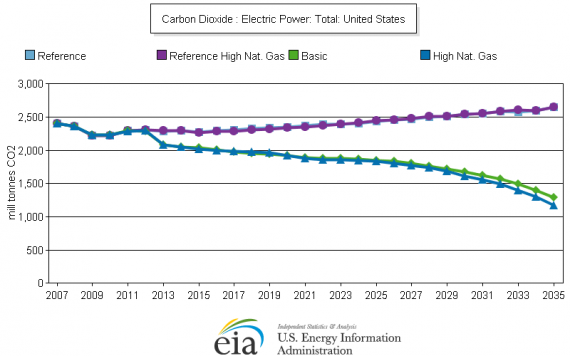Natural Gas and Climate Change: It’s Policy that Matters
More on:
Study after study seems to be reaching the same conclusion: abundant natural gas is no solution for climate change. Indeed some scientists, having looked at the numbers, have come to an even harsher conclusion: there is so much unconventional gas in the ground that our only hope for dealing with climate change is to leave it untouched.
The chart below, which is frequently invoked by skeptics of unconventional resource development, seems to reinforce the point. The amount of carbon contained in conventional oil and gas makes their extraction look tolerable, but the amount contained in unconventional gas (and in coal) is literally off the charts.

Alas this picture is hugely misleading. Here’s another series of charts that shows why.
The first chart shows four different estimates. The top two both show projected carbon dioxide emissions from the U.S. power sector; each has a different assumption about U.S. gas reserves. One assumes that natural gas is roughly as abundant as we thought it was in 2010, while the other assumes that reserves are substantially larger. You’ll notice that projected emissions are barely affected by the choice.

Now look at the bottom two lines. They’re both projections of what would have happened to power sector emissions had the Kerry-Lieberman cap-and-trade bill passed; one assumes moderate gas resources while the other assumes much larger ones. Those two lines are both radically lower than the ones without policy – but they’re both similar to each other. The lesson is simple: it’s the policy, not the gas resource, that matters most. Indeed if you look closely, emissions fall more if gas resources are larger, because gas with CCS becomes an economically attractive emissions-cutting option.
Perhaps this is an artifact of the particular policy? Nope. Here’s a similar chart, this time with a Clean Energy Standard rather than cap-and-trade. The pattern is the same.

None of this should surprise you. Absent demand-side policy, abundant natural gas displaces coal and renewable power, and increases electricity consumption. With demand-side policy, abundant natural gas displaces renewable and nuclear power, unless CCS isn’t available, in which case, by the 2030s, gas gets phased out.
But cheap natural gas does have one big bonus from a climate perspective: it makes cutting emissions less expensive. The lesson for people who care about climate change should be simple. Focus on constraining gas supplies, and even if you win, you’re unlikely to effect much change. Concentrate on demand side policy and your odds of victory may be longer, but a win will be far more worthwhile.
More on:
 Online Store
Online Store